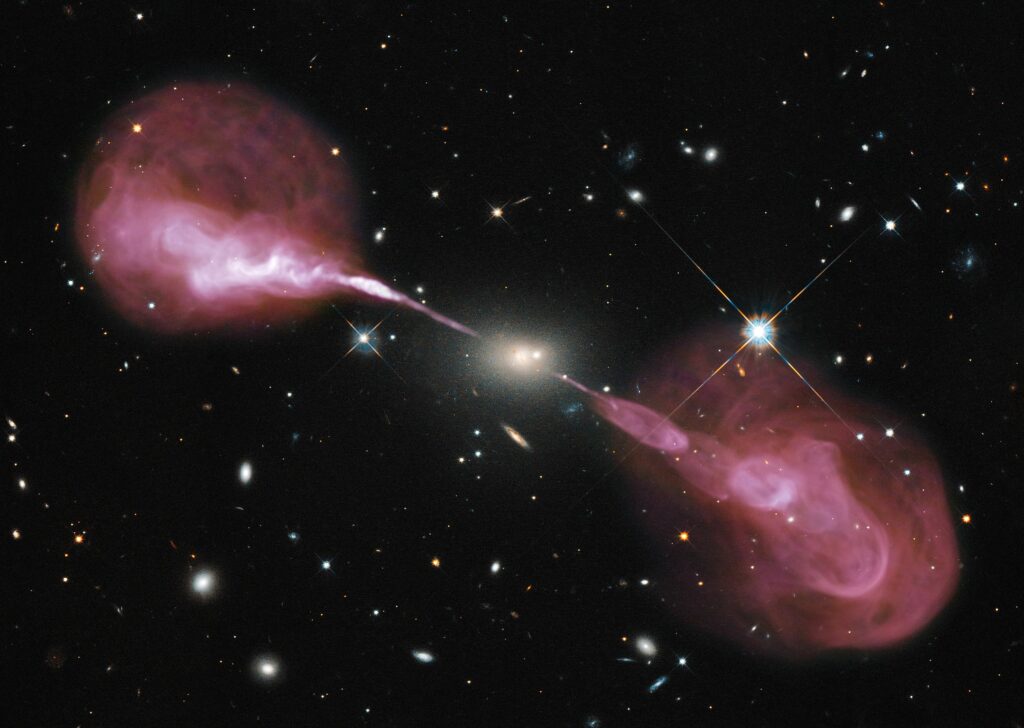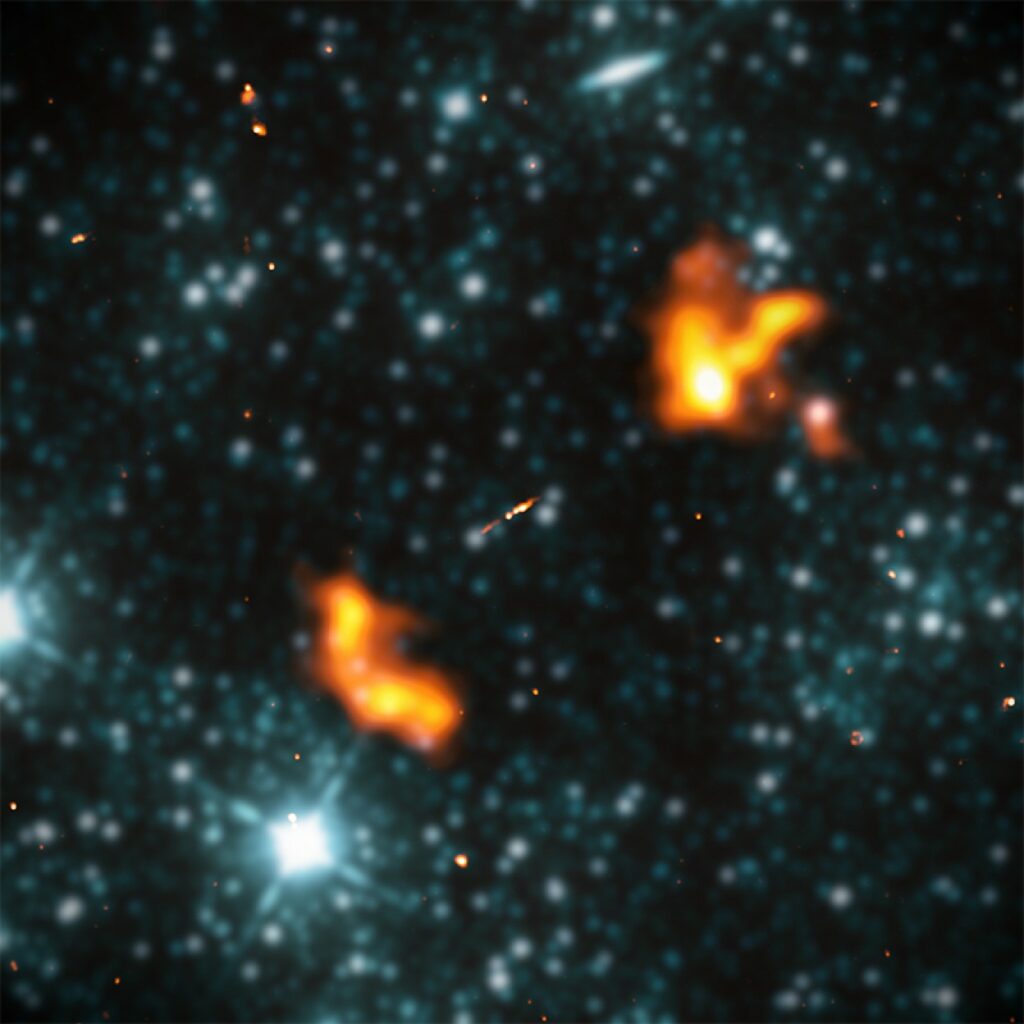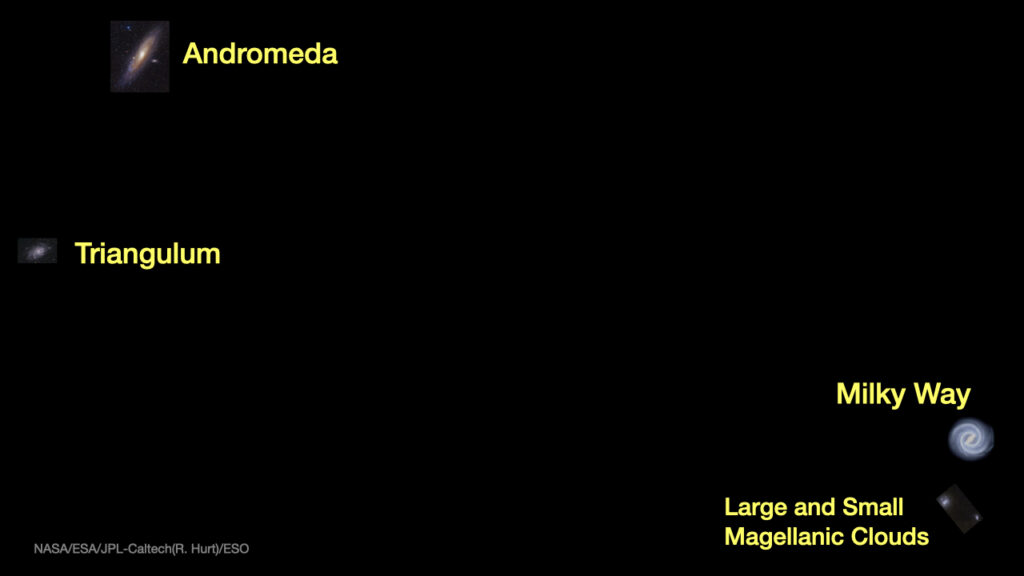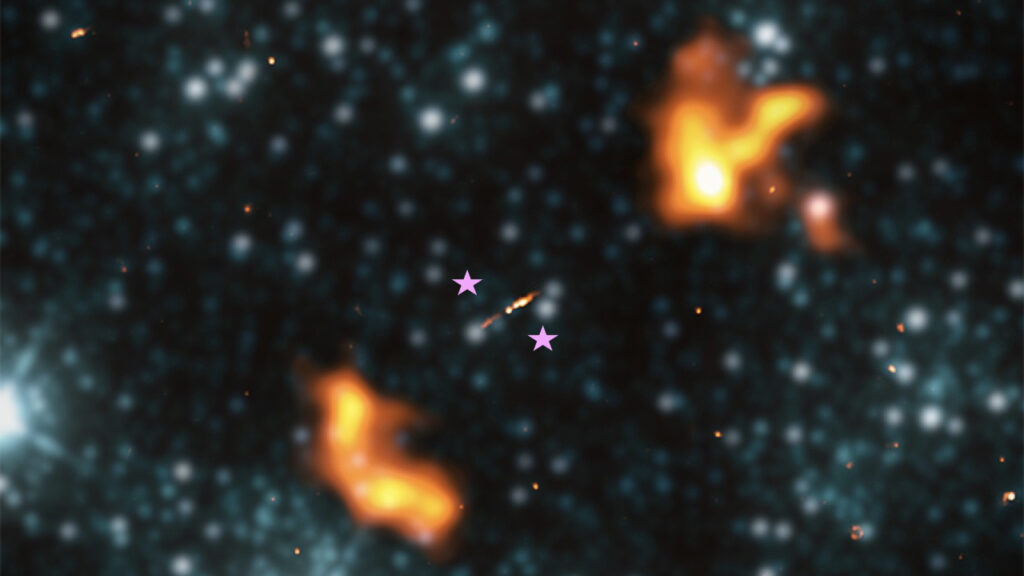Largest Galaxy Sheds Light on Big Bang Creation Event
During my stint at Caltech as a research fellow in radio astronomy, I spent much of my time at the Owens Valley Radio Observatory in eastern California. There I used an array of telescopes to study high-intensity synchrotron radiation being blasted out from quasars and supergiant galaxies. Synchrotron radiation is electromagnetic radiation emitted when charged particles are accelerated to relativistic velocities. Learning about this radiation shooting from lobes of giant galaxies yields data that informs cosmic creation models.
To express my appreciation for the observatory engineers and staff, I would bake “synchrotron cookies” for them. They told me my cookies were well named. They were the largest, most energy- and nutrient-dense cookies they ever ate, perfect for the long backpacking trips in the nearby Sierra Nevada Mountains we took during downtime.
Searching for Lobes
In the decades that have passed since my observing time, researchers continue to gain insight into these energy-intense features of galaxies. Giant radio galaxies (GRGs) are the largest cosmic structures generated by individual galaxies. They are characterized by active galactic nuclei that eject jets of synchrotron radiation. GRGs typically eject two jets at opposite (180°) directions from one another. The jets either gradually fade or end in huge, diffuse, hot lobes. The hot lobes of gas that do form radiate at low-frequency radio wavelengths. Figure 1 shows a typical GRG with far-flung lobes.

Figure 1: Hercules A (3C 348), a Giant Radio Galaxy
The radio image (pink) is superimposed over the optical image. 3C 348 is 1,000 times more massive than the Milky Way Galaxy.
Credit: NASA, ESA, S. Baum and C. O’Dea (RIT), R. Perley and W. Cotton (NRAO/AUI/NSF), and the Hubble Heritage Team (STScI/AURA)
Radio astronomers discovered GRGs 75 years ago. Since then, they have learned much about their characteristic features and the intense synchrotron radiation events that generate their jets and lobes. However, one major question about GRGs remained unanswered: is it the host galaxy’s characteristics that are responsible for the formation of the enormous far-flung lobes of hot diffuse gas, is it the characteristics of the intergalactic medium in the vicinity of the GRG, or is it a combination of both? To answer this question and understand its cosmological implications, a team of 12 astronomers led by Martijn Oei undertook an exhaustive study of the largest known GRGs.1
Oei’s team reprocessed the second and latest data release of the Low-Frequency Array (LOFAR) Two-Metre Sky Survey. Their reprocessing subtracted out compact radio sources and enhanced the image quality of diffuse, weak radiation sources. The result was, by far, “the most sensitive survey yet for radio galaxy lobes.”2
What Alcyoneus Shows
One outcome of Oei and his colleagues’ survey was the discovery of the largest known GRG, which they named Alcyoneus. In Greek mythology, Alcyoneus is the giant who fought Heracles. The projected proper length (length from the perspective of Earth) of Alcyoneus is 4.99 ± 0.04 megaparsecs (16.3 million light-years). The true length is, at minimum, 5.04 megaparsecs (16.4 million light-years). Figure 2 shows the galaxy’s stellar component (the tiny bright dot in the image center), the two jets emanating from opposite sides of the stellar component (the jet on the right is brighter than the jet on the left), and the two gigantic lobes. Figure 3 shows a to-scale map I constructed of the seven largest galaxies that comprise the Local Group: Andromeda Galaxy, Milky Way Galaxy, Large and Small Magellanic Clouds, Triangulum Galaxy, and the two large dwarf galaxies, M32 and NGC 205, that accompany the Andromeda Galaxy. In addition to these seven galaxies, the Local Group contains over a hundred small dwarf galaxies. Figure 3 shows the size of Alcyoneus compared to the distance separating the Andromeda and Milky Way Galaxies.

Figure 2: Giant Radio Galaxy Alcyoneus
Credit: Martijn Oei et al., Astronomy & Astrophysics 660 (April 2022): id. A2

Map credit: Hugh Ross; galaxy image credits: NASA/ESA/ESO/JPL-Caltech(R. Hurt)

Alcyoneus image credit: Martijn Oei et al., Astronomy & Astrophysics 660 (April 2022): id. A2
As gigantic as Alcyoneus is, it’s somewhat below average among the population of known GRGs. The progenitor of the two huge lobes is (1) an elliptical galaxy at a distance of 2.933 billion light-years with a stellar mass of 240 billion solar masses and (2) a supermassive black hole in its core with a mass equal to 400 million solar masses. While these masses are much greater than the Milky Way Galaxy’s stellar mass of 54 billion solar masses3 and supermassive black hole mass of 4 million solar masses,4 they rank at only the 25th and 23rd percentile, respectively, among GRGs.
The kinetic energy of Alcyoneus’s two jets is slightly below average for the known population of GRGs, a feature that surprised the astronomers. Yet, Alcyoneus’s two lobes possess record-breaking volumes of 1.5 (north lobe) and 1.0 (south lobe) million cubic parsecs (52 and 35 million cubic light-years). Oei and his colleagues calculated an equipartition pressure for the two lobes of 4.9 x 10-16 Pascals and an equipartition magnetic field strength of 46 picoteslas. For comparison, Earth’s surface air pressure = 101,325 Pascals and Earth’s average surface magnetic field strength = 0.000045 teslas.
Alcyoneus will get bigger. Its lobes are continuing to expand. The team measured the expansion velocity to be about 1% the velocity of light. With Alcyoneus’s northern lobe measuring 4.57 million light-years in diameter, its age = 2.28 million years. Hence, Oei’s team has provided yet another refutation of young-earth creationism.5
Among the 151 GRGs with known lobe pressures, Alcyoneus has, by far, the lowest lobe pressure. It is so low that it is comparable to the pressure of the warm-hot intergalactic medium. The astronomers’ discovery and study of Alcyoneus establishes that neither extremely massive galaxies nor extremely massive supermassive blackholes are necessary to grow very large lobes of low radio frequency radiation. Rather, the explanation for Alcyoneus’s enormous lobes is that it resides in a low-density part of the intergalactic medium.
Affirmation of Big Bang Creation
It took a painstaking analysis of the LOFAR second data release to detect Alcyoneus. More sensitive low radio frequency surveys have the potential to detect many more GRGs with lobes as big or bigger than Alcyoneus’s. The future discovery of GRGs with lobes as large or larger than Alcyoneus’s would give astronomers a potent barometer to map the properties of the intergalactic medium. Such a capability will yield a more precise and detailed cosmic creation model.
Already, the discovery and measurements achieved by Oei’s team show that increasing knowledge about GRGs and the intergalactic medium is yielding increasing consistency with the ΛCDM big bang creation model, where dark energy, Λ, is the primary component of the universe and cold dark matter, CDM, is the second most dominant component. While astronomers in the twentieth and twenty-first centuries discovered and established that the universe must have arisen from a big bang creation event, it was six Bible authors writing 2,500–3,500 years ago who first predicted that the universe possesses the four most fundamental properties of a big bang universe.6
Check out more from Reasons to Believe @Reasons.org
Endnotes
- Martijn S. S. L. Oei et al., “The Discovery of a Radio Galaxy of at Least 5 Mpc,” Astronomy & Astrophysics 660 (April 2022): id. A2, doi:10.1051/0004-6361/202142778.
- Oei et al., “The Discovery of a Radio Galaxy,” p. 1.
- Paul J. McMillan, “The Mass Distribution and Gravitational Potential of the Milky Way,” Monthly Notices of the Royal Astronomical Society 465, no. 1 (February 11, 2017): 76–94, doi:10.1093/mnras/stw2759.
- The GRAVITY Collaboration, R. Abuter et al., “A Geometric Distance Measurement to the Galactic Center Black Hole with 0.3% Uncertainty,” Astronomy & Astrophysics: Letters 625 (May 2019): id. L10, doi:10.1051/0004-6361/201935656.
- For a comprehensive biblical and scientific refutation of young-earth creationism, see my book, A Matter of Days: Resolving a Creation Controversy, 2nd exp. ed. (Covina, CA: RTB Press, 2015).
- Hugh Ross and John Rea, “Big Bang—The Bible Taught It First!” Reasons to Believe, July 1, 2000; Hugh Ross, “Does the Bible Teach Big Bang Cosmology?“ Today’s New Reason to Believe (blog), Reasons to Believe, August 26, 2019.





